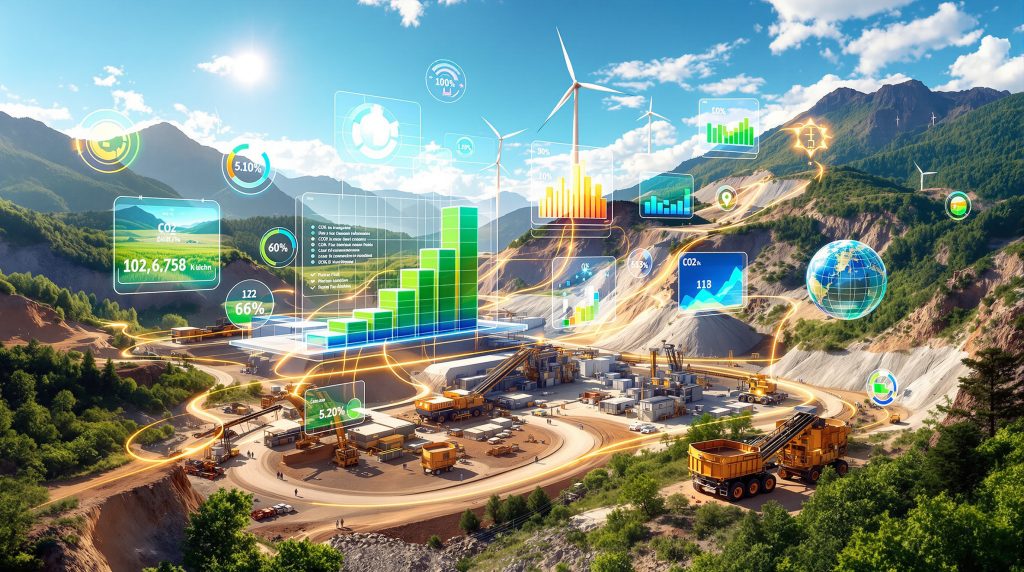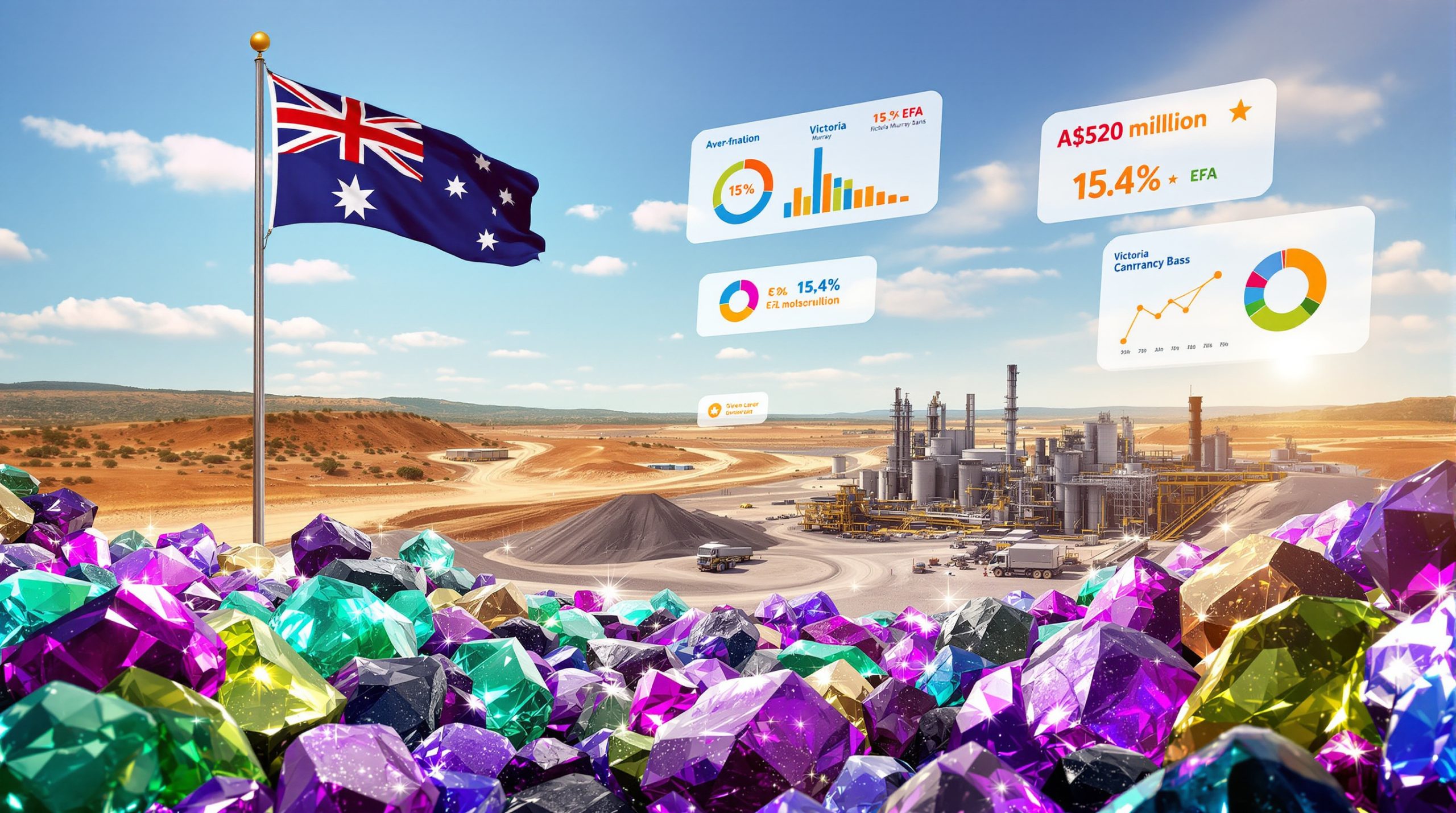Understanding Carbon Credits for Mining: The Foundation of Sustainable Operations
Carbon credits for mining function as tradeable certificates representing verified reductions in greenhouse gas emissions, with each unit equivalent to one metric ton of CO2 removed or prevented from entering the atmosphere. For mining operations, traditionally among the most carbon-intensive industries, these instruments provide a pathway to environmental compliance while maintaining operational efficiency.
The mining and metals sector accounts for 4-7% of global greenhouse gas emissions according to the International Council on Mining and Metals, with Scope 1 and 2 emissions from mining operations totaling approximately 1 Gt CO2e in 2022 as reported by the International Energy Agency. This substantial environmental footprint places mining companies under increasing pressure from investors, regulators, and stakeholders to demonstrate measurable progress toward sustainability goals. However, the decarbonisation benefits extend far beyond compliance, offering significant economic advantages.
Key Carbon Credit Categories for Mining:
• Renewable energy project certificates
• Forest restoration and conservation initiatives
• Methane capture from industrial processes
• Carbon sequestration through geological storage
• Industrial waste-to-energy conversions
Carbon credits allow mining companies to offset unavoidable emissions by purchasing verified environmental projects, helping achieve net-zero targets without halting production.
The Business Case for Carbon Credit Investment
Mining companies face mounting pressure from multiple stakeholders to demonstrate environmental responsibility. Furthermore, carbon credits for mining operations offer measurable progress toward sustainability goals while potentially generating revenue through internal emission reduction projects. The global voluntary carbon market was valued at approximately $2 billion in 2023 according to Forest Trends, with significant growth projected as more companies commit to net-zero targets.
Financial Benefits Include:
• Avoiding regulatory penalties in cap-and-trade systems
• Improving ESG ratings for better investor relations
• Accessing green financing opportunities
• Creating additional revenue streams from carbon-positive projects
Global sustainable investment assets reached $30.3 trillion in 2022, representing approximately 36% of total managed assets according to the Global Sustainable Investment Alliance. This massive capital pool increasingly favours companies with strong environmental credentials, making carbon credit investments strategically valuable beyond compliance requirements. Moreover, companies embracing comprehensive sustainability transformation strategies are witnessing enhanced investor confidence and access to preferential financing terms.
Which Types of Carbon Credits Work Best for Mining Operations?
Different mining sectors require tailored approaches to carbon offsetting based on their specific emission profiles and operational characteristics. The effectiveness of carbon credit types varies significantly depending on geographical location, mining method, and processed materials.
Industrial Carbon Capture Solutions
Large-scale mining operations can implement carbon capture and storage (CCS) technologies to trap emissions directly from processing facilities. Global CCS capacity reached 49 million tonnes per annum (Mtpa) of CO2 in 2023, with 42 operational facilities worldwide according to the Global CCS Institute. This approach works particularly well for:
• Cement and limestone processing operations
• Metal smelting and refining facilities
• Coal-fired power generation at mine sites
• Chemical processing plants
The Australian Carbon Credit Unit Scheme provides a regulatory framework for companies seeking to generate domestic offsets through verified emission reduction projects.
Nature-Based Carbon Solutions
Mining companies with extensive land holdings can develop internal carbon credit projects through restoration and conservation initiatives. Nature-based solutions represented 58% of voluntary carbon credit issuances in 2022 according to Forest Trends, making them a dominant market segment.
Reforestation Programs:
• Restoring degraded mining areas with native vegetation
• Creating carbon sinks on unused portions of mining leases
• Establishing buffer zones around active operations
Soil Carbon Enhancement:
• Implementing regenerative agriculture on reclaimed land
• Using biochar applications to increase soil carbon storage
• Converting mine waste areas into carbon-sequestering ecosystems
The African Forest Landscape Restoration Initiative (AFR100) aims to restore 100 million hectares of deforested land across Africa by 2030, creating significant carbon credit opportunities for mining companies operating on the continent.
Innovative Carbon Mineralisation Technologies
Emerging technologies allow mining companies to transform waste materials into permanent carbon storage solutions. Mine tailings and waste rock can undergo accelerated weathering processes that permanently bind atmospheric CO2 into stable mineral forms, as documented in research published by the Chemical Society Reviews.
Technical Process Overview:
-
Crushing and preparing alkaline mine waste materials
-
Exposing materials to CO2-rich environments
-
Accelerating natural carbonation reactions
-
Monitoring and verifying permanent carbon storage
Navigating Carbon Credit Markets: Compliance vs. Voluntary Options
Understanding the distinction between compliance and voluntary carbon markets helps mining companies develop appropriate offsetting strategies. These markets operate under different regulatory frameworks and offer varying levels of flexibility and pricing structures.
Compliance Carbon Markets
Government-mandated cap-and-trade systems require mining companies to hold allowances for their emissions. Global carbon pricing revenues reached $95 billion in 2022 according to the World Bank, demonstrating the substantial financial impact of these regulatory mechanisms.
Major Compliance Markets:
| Market System | Coverage | Average Price (2023) | Key Features |
|---|---|---|---|
| EU ETS | 40% of EU emissions | €84 per tonne | Covers power generation and energy-intensive industries |
| California-Quebec | 450 million tonnes CO2e | $30-35 per tonne | Linked system with auction mechanism |
| RGGI | Northeast US power sector | $13-15 per tonne | First mandatory cap-and-trade program in US |
Voluntary Carbon Markets
Companies can proactively purchase credits beyond regulatory requirements to achieve corporate sustainability goals. The voluntary carbon market provides flexibility in project selection and timing, with average prices ranging from $3-4 per tonne in 2023, though premium projects with strong co-benefits command significantly higher prices.
Voluntary markets provide:
• Flexibility in project selection and timing
• Opportunity to support specific environmental co-benefits
• Enhanced corporate reputation and stakeholder engagement
• Potential for premium pricing on high-quality credits
Comprehensive resources like carbon credits explained offer detailed guidance for companies navigating these complex market dynamics.
Key Implementation Strategies for Mining Companies
Successful carbon credit integration requires systematic planning and execution across multiple operational areas. Companies must establish baseline measurements, identify reduction opportunities, and implement monitoring systems to ensure program effectiveness.
Conducting Comprehensive Emissions Assessments
Before entering carbon markets, mining companies must establish baseline emission measurements following the GHG Protocol Corporate Accounting and Reporting Standard. The mining sector typically sees Scope 1 emissions account for 40-60% of total emissions, primarily from diesel fuel for equipment, while Scope 2 emissions account for 30-50% from purchased electricity.
Scope 1 Emissions (Direct):
• Fuel combustion in mining equipment
• On-site power generation
• Processing and refining operations
• Transportation of materials
Scope 2 Emissions (Indirect):
• Purchased electricity consumption
• Steam and heating from external sources
• Cooling systems and compressed air
Scope 3 Emissions (Value Chain):
• Supplier and contractor activities
• Product transportation and distribution
• End-of-life product treatment
Developing Internal Carbon Projects
Mining companies can generate their own carbon credits by implementing emission reduction projects that meet verification standards. The levelised cost of electricity for utility-scale solar PV fell to $40-50/MWh in 2023, making renewable energy installations increasingly cost-competitive with traditional power sources. Additionally, innovative energy transition strategies are being developed specifically for the mining sector.
Renewable Energy Installations:
• Solar panel arrays on mine infrastructure
• Wind turbine installations in suitable locations
• Hydroelectric systems using mine water flows
• Geothermal energy from underground operations
Energy Efficiency Improvements:
• Equipment electrification and automation
• Heat recovery systems in processing facilities
• LED lighting conversions across operations
• Smart grid implementations for power optimisation
How Carbon Credits Support Mining Industry Decarbonisation Goals
The mining sector's transition toward net-zero operations requires both immediate offsetting solutions and long-term structural changes to reduce absolute emissions. As of 2023, over 30 major mining companies representing approximately 30% of global mining emissions have committed to net-zero targets by 2040-2050 according to the International Council on Mining and Metals. Recent innovation expo insights demonstrate how technology partnerships are accelerating this transition.
Short-Term Emission Mitigation
Carbon credits for mining provide immediate environmental impact while companies implement longer-term decarbonisation strategies. This approach allows mining companies to demonstrate progress on climate commitments without disrupting ongoing operations or compromising production targets.
| Strategy | Timeline | Impact Level | Implementation Cost |
|---|---|---|---|
| Purchased Offsets | Immediate | High | Low-Medium |
| Renewable Energy | 1-3 years | Medium-High | High |
| Equipment Electrification | 3-5 years | High | Very High |
| Process Innovation | 5-10 years | Very High | Very High |
Long-Term Transformation Planning
Mining companies must balance immediate carbon credit purchases with investments in fundamental operational changes. Onshore wind LCOE averaged $30-40/MWh in 2023 according to the International Renewable Energy Agency, making renewable energy increasingly attractive for long-term power supply contracts.
Technology Integration Roadmap:
-
Phase 1 (0-2 years): Purchase high-quality offsets while planning infrastructure changes
-
Phase 2 (2-5 years): Implement renewable energy systems and efficiency improvements
-
Phase 3 (5-10 years): Deploy breakthrough technologies like hydrogen fuel cells and carbon capture
-
Phase 4 (10+ years): Achieve net-positive carbon impact through advanced sequestration projects
Challenges Mining Companies Should Expect
Carbon credit implementation presents both technical and market-related obstacles that require careful navigation. The complexity of verification standards and market volatility creates risks that must be actively managed through diversified strategies.
Quality and Verification Concerns
Not all carbon credits offer equivalent environmental value. Mining companies must evaluate projects against rigorous standards established by organisations like Verra's VCS and Gold Standard to ensure genuine environmental impact.
Additionality Requirements:
• Projects must demonstrate emissions reductions beyond business-as-usual scenarios
• Clear evidence that carbon financing enabled the project
• Robust baseline methodologies for measuring impact
Permanence Considerations:
• Long-term storage guarantees for sequestration projects
• Risk management for reversible offsets (forest fires, disease)
• Insurance mechanisms to protect against credit losses
Buffer pools typically hold 10-20% of forest-based credits in reserve to address non-permanence risks according to Verra's VCS Program Guide, providing some protection against project failures but reducing the net carbon impact of purchases.
Market Price Volatility
Voluntary carbon credit prices ranged from $1-50+ per tonne in 2023 depending on project type, vintage, and co-benefits according to Forest Trends. This significant price variation creates both opportunities and risks for mining companies developing carbon credit strategies.
Companies should:
• Diversify across multiple project types and regions
• Consider long-term purchasing agreements for price stability
• Monitor regulatory developments that could affect credit values
• Maintain flexibility to adjust strategies based on market conditions
Measuring Carbon Credit Success for Mining Operations
Effective monitoring and reporting systems ensure carbon credit investments deliver intended environmental and business benefits. Mining companies must establish clear performance indicators and align reporting with established international frameworks.
Key Performance Indicators
Environmental Metrics:
• Total CO2 equivalent offsets purchased annually
• Percentage of Scope 1, 2, and 3 emissions covered
• Verification standards met for purchased credits
• Co-benefits achieved (biodiversity, water quality, community development)
Business Metrics:
• Cost per ton of CO2 offset across different project types
• ESG rating improvements following carbon credit investments
• Regulatory compliance status and penalty avoidance
• Stakeholder satisfaction with sustainability initiatives
Reporting and Transparency Standards
Mining companies should align their carbon credit reporting with established frameworks to ensure consistency and credibility. The Financial Stability Board's Task Force on Climate-related Financial Disclosures published its 2023 Status Report highlighting continued growth in TCFD adoption across industries, including mining.
International Standards:
• Task Force on Climate-related Financial Disclosures (TCFD)
• Global Reporting Initiative (GRI) sustainability standards
• Carbon Disclosure Project (CDP) reporting requirements
• Science-Based Targets initiative (SBTi) guidelines
The Future of Carbon Credits in Mining
Technological advances and regulatory developments will reshape how mining companies approach carbon offsetting in the coming decade. Market projections suggest the voluntary carbon market could reach $50-100 billion by 2030 under various growth scenarios, according to McKinsey & Company analysis.
Emerging Technologies and Opportunities
Next-Generation Carbon Capture:
• Direct air capture systems powered by renewable energy
• Enhanced weathering using mining waste materials
• Biochar production from organic waste streams
• Ocean-based carbon removal technologies
Blockchain and Digital Verification:
• Transparent tracking of carbon credit ownership and transfers
• Automated verification through satellite monitoring
• Smart contracts for conditional credit purchases
• Real-time emission monitoring and offset matching
Regulatory Evolution and Market Growth
Government policies increasingly support carbon credit markets through mandatory corporate emission reporting requirements and tax incentives for verified offset purchases. The Paris Agreement's Article 6 mechanisms establish frameworks for international cooperation on carbon markets, including Internationally Transferred Mitigation Outcomes (ITMOs) and sustainable development mechanisms. Furthermore, Australia's green metals leadership position creates additional opportunities for domestic carbon credit generation.
Market Projections:
• Voluntary carbon market expected to reach $100+ billion by 2030
• Increasing demand for high-quality, verified credits
• Growing premium for credits with measurable co-benefits
• Consolidation of verification standards and methodologies
Africa's Strategic Position in Carbon Markets
African leaders have positioned the continent as having minimal greenhouse gas emissions while facing maximum vulnerability to climate change impacts. The Addis Ababa Declaration, adopted in September 2025 at the Second African Climate Summit in Ethiopia, outlined Africa's unified stance on climate action, emphasising adaptation, African-led solutions, and urgent global financial reform.
The declaration emphasised Africa as a continent of opportunities and potential, calling for investment and integration of peace, security, and climate frameworks into action. This positioning creates significant opportunities for mining companies operating in Africa to participate in carbon credit projects that deliver both environmental and development co-benefits.
Building a Sustainable Mining Future Through Carbon Credits
Carbon credits for mining represent a crucial bridge technology enabling mining companies to address immediate emission reduction needs while developing long-term decarbonisation capabilities. Success requires strategic planning, quality project selection, and integration with broader sustainability initiatives.
The progressive importance of climate dialogues has increased significantly since the 1992 Earth Summit in Rio de Janeiro, which established the UN Framework Convention on Climate Change. The Kyoto Protocol of 1997 created flexible mechanisms that formed the foundation for modern carbon trading systems, while the Paris Agreement of 2015 set ambitious warming limits and introduced comprehensive frameworks balancing mitigation, adaptation, finance, and technology transfer.
Mining companies that proactively engage with carbon markets position themselves advantageously for future regulatory requirements while demonstrating environmental leadership to stakeholders. The key lies in viewing carbon credits for mining not as a final solution, but as one component of a comprehensive approach to sustainable mining operations.
As carbon markets mature and new technologies emerge, mining companies must remain adaptable, continuously evaluating their carbon credit strategies against evolving best practices and market opportunities. Those who act decisively today will be best positioned to thrive in tomorrow's carbon-constrained economy, particularly as Africa emerges as a continent of opportunities seeking investment in climate-positive projects.
This analysis incorporates insights from the Carbon Markets Africa Summit held October 21-23, 2025, reflecting the latest developments in carbon market mechanisms and African climate policy positions. Readers interested in exploring carbon market opportunities should consider engaging with verified project developers and established trading platforms to ensure quality and additionality in their offset purchases.
Ready to Identify the Next Major Mineral Discovery?
Discovery Alert's proprietary Discovery IQ model delivers real-time alerts on significant ASX mineral discoveries, instantly empowering subscribers to identify actionable opportunities ahead of the broader market. Understand why historic discoveries can generate substantial returns by exploring Discovery Alert's dedicated discoveries page, showcasing proven examples of exceptional market outcomes, and begin your 30-day free trial today to position yourself ahead of the market.




